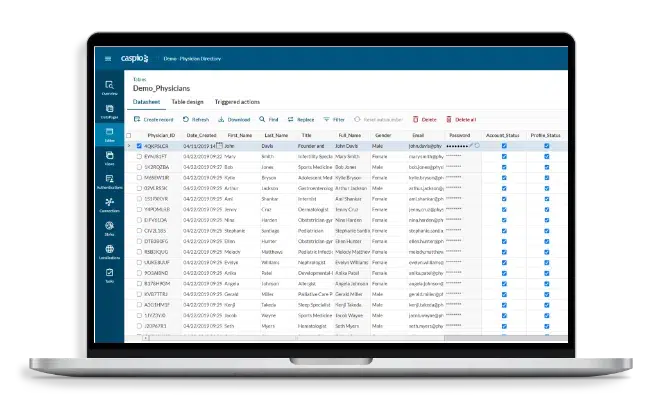Discover How Scalable Databases Can Be Made Use Of Without Coding to Enhance Your Service Operations
In today's busy company environment, the capacity to manage and evaluate data effectively is vital. no-code. Scalable databases, especially when combined with no-code solutions, offer a transformative method that empowers non-technical users to streamline operations.
Recognizing Scalable Databases
Scalable data sources are essential for contemporary organization operations, permitting organizations to successfully manage raising volumes of information without compromising performance. These data sources are developed to adjust and grow to the altering demands of a company, making certain that they can handle bigger datasets and even more complex queries as business requirements progress.
Recognizing scalable databases includes identifying their 2 key types: upright scaling and straight scaling. Upright scaling, or "scaling up," entails adding even more power (CPU, RAM) to an existing web server to boost efficiency. Alternatively, horizontal scaling, or "scaling out," entails adding a lot more web servers to disperse the tons, which frequently leads to better flexibility and fault tolerance.
One more essential aspect is the architecture of scalable data sources, which can be either relational or non-relational. Relational data sources, such as MySQL and PostgreSQL, are structured and use SQL for questions, while non-relational databases, like MongoDB and Cassandra, supply more adaptability with unstructured data.
Eventually, understanding scalable databases is vital for services intending to take advantage of data as a critical asset, allowing them to remain competitive in a progressively data-driven setting.

Benefits of No-Code Solutions
Opening the possibility of no-code options empowers organizations to enhance operations and enhance performance without the need for extensive shows expertise. These systems permit non-technical individuals to produce, customize, and handle data sources effortlessly, therefore democratizing access to modern technology throughout groups.
Among the primary benefits of no-code remedies is their speed of application. Organizations can swiftly deploy applications and automate procedures, significantly lowering the time spent on advancement cycles. This agility enables organizations to react promptly to market adjustments and customer demands, cultivating an affordable side.
In addition, no-code platforms reduce dependence on IT departments for day-to-day jobs, enabling technological groups to focus on even more complex tasks that call for specialized abilities. This shift not just maximizes source allocation but also promotes innovation within the company.
Cost-effectiveness is an additional benefit, as no-code remedies can decrease advancement and maintenance costs. By decreasing the demand for coding knowledge, business can harness the abilities of their existing workforce without the expenses of hiring added personnel.
Popular No-Code Database Tools
The rise of no-code services has caused the emergence of various database devices that accommodate businesses looking for efficiency and access. These devices encourage customers with minimal technological know-how to produce, handle, and control data sources flawlessly.

Caspio stands apart for its ability to construct internet applications without any type of coding. It allows organizations to produce robust databases and release applications swiftly, accommodating various sector demands. Flair supplies effective information and user-friendly user check my source interfaces monitoring capacities, making it possible for companies to develop customized applications customized to their operations.

Usage Cases in Organization Operations
How can services leverage database devices to boost their operations? Scalable databases give organizations with powerful abilities to take care of and assess information without the demand for extensive coding knowledge. These devices can simplify different service procedures, ultimately bring about boosted efficiency and efficiency.
One famous use instance is client connection management (CRM) Companies can utilize scalable data sources to track client interactions, choices, and feedback, enabling personalized interaction and much better service. By systematizing this info, groups can work together better and reply to client needs in real-time.
An additional significant application is supply administration. Firms can utilize no-code database blog here tools to monitor stock degrees, track deliveries, and forecast need. This guarantees optimum stock levels, lowers waste, and lessens stockouts.
Additionally, task monitoring can take advantage of scalable data sources by enabling groups to manage tasks, deadlines, and resources in an unified system. With real-time updates and information visualization, project supervisors can make educated decisions.
Starting With Execution
Applying scalable databases in service operations calls for a structured method to ensure successful assimilation and application. The first step is to carry out a comprehensive requirements assessment, identifying certain company requirements, data types, and expected development patterns. This foundational understanding will certainly lead the option of the suitable data source remedy.
Following, pick an user-friendly, no-code database platform that lines up with your operational goals. no-code. Numerous modern-day remedies provide instinctive interfaces, permitting non-technical individuals to handle data successfully. After selecting a system, develop a clear information architecture that outlines how data will be arranged, accessed, and kept
Training is critical; ensure that employee are outfitted with the essential abilities to utilize the data source. Consider Discover More Here providing workshops or tutorials to acquaint personnel with the system's performances.
Final Thought
Finally, the integration of scalable data sources via no-code options provides significant benefits for organization operations. These systems empower non-technical users to successfully handle and evaluate data, facilitating boosted decision-making and partnership. By embracing tools such as Airtable and Idea, organizations can lower and enhance processes dependence on IT resources. Ultimately, leveraging these innovations can lead to improved performance and operational efficiency, placing companies for sustained development in a competitive landscape.
One popular no-code data source tool is Airtable, which integrates the capability of a spread sheet with the power of a database.How can services utilize data source devices to improve their operations? Organizations can utilize scalable data sources to track consumer communications, preferences, and responses, enabling individualized communication and far better solution.Executing scalable data sources in service procedures requires a structured approach to make certain successful assimilation and utilization.In conclusion, the combination of scalable databases with no-code solutions offers significant benefits for company procedures.